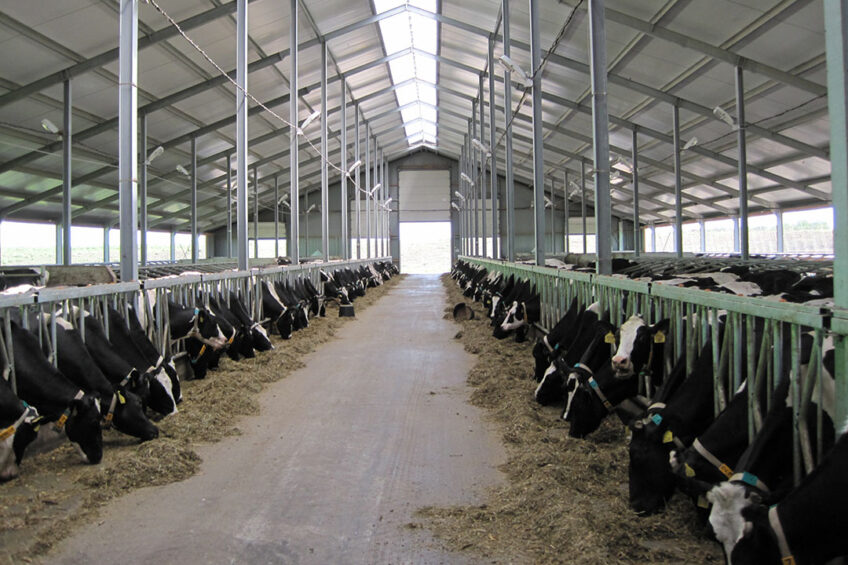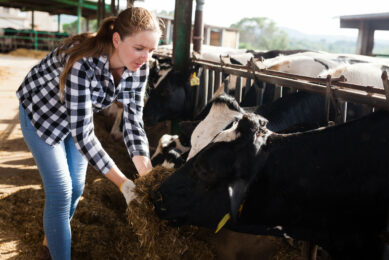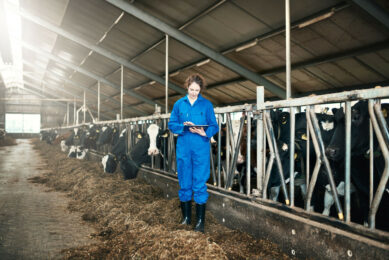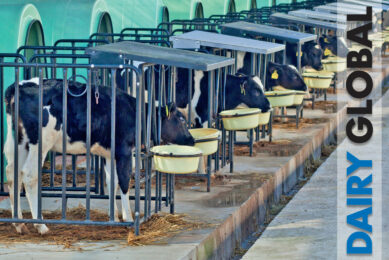New advancements in udder health management

Differential somatic cell count (DSCC) is a new supplementary parameter to SCC for udder health management. Using these 2 parameters in combination leads to better identification of mastitis at the end of the lactation period and thus can be valuable regarding dry cow therapy decisions.
Somatic cell count (SCC) in milk provide an indication of the inflammatory response in the mammary gland thus are a well-established indicator for mastitis, also at the end of the lactation period. However, SCC does not distinguish the individual immune cells occurring in milk. Besides SCC, the composition of the immune cells changes evidently during mastitis. Changes in the composition of immune cells have even been described for cases where SCC stayed at low levels. Specifically, macrophages mainly having surveillance functions are the predominant cell population in milk of healthy udder quarters. On the other hand, polymorphonuclear neutrophils (PMN or granulocytes) having the main function to phagocytise and thus eliminate bacteria are the predominating cell population in milk of inflamed quarters. The third population of immune cells are lymphocytes regulating the immune response and they occur in fairly low concentrations in milk. The new DSCC parameter represents the combined proportion of granulocytes and lymphocytes as a percentage of SCC, and, similarly to SCC, elevated DSCC results can be associated with presence of mastitis. FOSS has developed a new generation of high-throughput milk analysers that allow simultaneous measurement of SCC and DSCC. These instruments are typically applied for analysis of dairy herd improvement (DHI) samples and located in milk-testing laboratories.

Selective dry cow therapy
Around 70% to 75% of antimicrobials applied on dairy farms are used in connection with udder health, either in form of treatments or in a preventive manner. Half of all antibiotics are used for dry cow treatment alone. Hence, selective dry cow therapy is a highly valuable tool to reduce the consumption of antimicrobials on dairy farms, as is desired by the general public being concerned about the increasing threat of antimicrobial resistance in human and veterinary medicine. Selective dry cow therapy based on DHI records (mainly SCC) is already performed in many countries since several years (e.g. the Netherlands) and has led to an apparent reduction in the use of antimicrobials. This background, the availability of the new DSCC technology and the fact that DHI samples are typically readily available from each lactating cow enrolled to a DHI programme once per month led us to investigate the new DSCC parameter as an additional indicator for mastitis at the end of the lactation period in a specifically designed study.
 New ‘cure’ to tackle mastitis
New ‘cure’ to tackle mastitis
With such a great emphasis on reducing the use of antibiotics in livestock farming these days a number of new ‘cures’ for mastitis have been developed.
Testing for the presence of pathogens
Ghent University and FOSS collaborated with 15 dairy farms in Flanders, Belgium, having on average 91 cows. During the 8 month study period, DHI samples were collected routinely and, in addition, hand-stripped samples (one sample per cow) representing an equal amount of approximately 2.5 mL of milk from each quarter were collected from cows in the period 5 days before dry-off right before attaching the milking clusters at one of the milking’s in that period. Beyond that, aseptic quarter foremilk samples were collected at one of the milking’s in the same period. While the DHI and hand-stripped samples were analysed for SCC and DSCC, the aseptic quarter foremilk samples were tested for presence of mastitis pathogens using bacteriological culture.
The final data set comprised of 310 cows of which 64 were infected with major pathogens such as Staphylococcus aureus, Streptococcus uberis, Streptococcus dysgalactiae, and E. coli, 149 were infected with minor pathogens such as non-aureus staphylococci and Corynebacterium sp., and 97 were uninfected. SCC results varied widely from 9,000 to 6,925,000 cells/mL and DSCC results were found in a wide range from 0 to 89.5%. DSCC results indicated a particularly broad variation in the SCC range below 400,000 cells/mL and were found to be generally elevated in samples with higher SCC (Figure 1). Given that a defined volume of milk is analysed during the simultaneous measurement of SCC and DSCC, the number of cells available to determine DSCC depends on the total number of cells available per mL of milk. In this context, DSCC cannot be determined reliably in samples with SCC <50,000 cells ml because they are outside the performance range. thus, the instrument sets dscc results to 0% in such samples – however, we have set them to 45% in our study meaning a predominance of macrophages is indicated.>
Figure – 1 Differential somatic cell count (DSCC) versus SCC results in DHI samples taken during last milk recording within 42 d prior to dry-off according to pathogens detected: (x) no(n = 97), minor (n = 149), (Δ) major pathogens (n = 64). Each symbol represents the results of the DHI sample/cow but overlapping is possible.

Nevertheless, an interesting finding of our study was that the majority (45 out of 65, meaning 70%) of cows with mastitis caused by major pathogens revealed DSCC results of >50% regardless of the SCC result (Figure 1, Table 1). Considering SCC as well (Table 1), it becomes evident that the prevalence of major pathogen infections increases within SCC ranges as DSCC results increase. For example, the prevalence of major pathogen infections in the SCC range 50,000 to 200,000 cells/mL nearly doubled from 14.3% at DSCC of <50% to 26.1% at dscc of>70%.
A combination of SCC and DSCC
The actual test characteristics, specifically sensitivity, specificity, negative and positive predictive values, were evaluated for detection of mastitis caused by major pathogens (because treatment of infections caused by minor pathogens is unwanted). Test characteristics were determined separately for DHI samples and hand-stripped samples. In both cases, the test characteristics were established for using SCC alone, DSCC alone, and the combination of SCC and DSCC each as indicator to identify infections caused by major pathogens. All results of this analysis are summarised in Table 2. Most interestingly, classifying cows as infected based on a cut-off of 200,000 cells/mL for SCC alone and in terms of using SCC combined with DSCC based on either >60% and/or >200,000 cells/mL, the sensitivity changed from 47 to 66% and the specificity from 74 to 54%. More specifically, the number of correctly identified infections could be increased by 40% from 30 to 42 when adding DSCC as an indicator in this case. At the same time, the negative predictive value changed from 84 to 86% and the positive predictive value from 32 to 27%. It is worth noting that DHI samples were collected in the period up to 42 days before dry-off. Our study confirmed that DHI samples are offering a valuable indication of the intramammary infection status by the time cows are dried off.
Sensitivity could generally be improved by changing from a higher to a lower SCC cut-off. However, the findings from our study show that sensitivity can be improved when adding DSCC as an additional indicator, even if the SCC cut-off remains unchanged. Such an improvement in sensitivity is of practical importance because the identification of as many infections by major pathogens is clearly desired in terms of dry cow therapy. Without any doubt such cases present a risk for udder health issues at the beginning of the subsequent lactation when they are undetected and left untreated at dry-off. At the same time, truly healthy cows should not be treated to reduce the consumption of antimicrobials. Thus, parameters and cut-offs with the highest sensitivity and negative predictive value would be the best choice for basing dry cow therapy decisions on.
 Initiative to improve consistency in milk SCC
Initiative to improve consistency in milk SCC
The EC’s Joint Research Centre announced the launch of the first certified reference materials for somatic cell counting in milk.
Results from hand-stripped samples
Another interesting finding was that the test characteristics of DHI samples and hand-stripped samples are at the same levels (Table 2). This highlights that the additional effort connected with collection of hand-stripped samples in the time period 5 days before dry off would not be justified in cows that are enrolled for DHI testing anyway. Nevertheless, it could be recommendable and worthwhile to perform a California mastitis test on the day of dry off to confirm the validity of the results obtained through the last DHI testing (e.g. confirm absence of mastitis) and include the results in the decision making process regarding dry cow therapy. The findings mentioned above further highlight that it would be recommendable to collect a hand-stripped sample in the period 5 days before dry off for cows that are not enrolled to DHI programmes and work with the results in terms of the dry cow therapy decision. It should be noted that we used bacteriological culture for identification of mastitis pathogens and thus the definition of the mastitis status of cows at the end of lactation. However, it can come to misclassification (in particular false-negatives) of the mastitis status, e.g. because of intermittent shedding of mastitis pathogens, shedding of too-low small numbers of the pathogens and ceased growth of pathogens. On the other hand, major mastitis pathogens were identified in the low SCC area in previous studies and interpreted as mastitis in its early stage based on elevated proportions of PMN/DSCC
 Pathogens & Prevention – special publication
Pathogens & Prevention – special publication
Diseases are always just a stone’s throw away from any livestock herd/flock and producing healthy and safe animal products is key for a successful business. In this special we focus on how to keep diseases at bay via biosecurity measures, management and nutritional interventions.
Conclusions
Our study provides first insights on utilising the new DSCC parameter as a supplementary tool to SCC in connection with dry cow therapy decisions. The new parameter allows to improve sensitivity for identification of major pathogen infections at the end of lactation and thus helps to lower the risk that cows with such infections are dried off untreated. Yet, more work is needed to refine the practical application of this tool. Moreover, other practical applications of the new DSCC-based udder health management tool are identification of mastitis in its early stage and chronically infected cows during the lactation period.
This is a condensed version of the original research paper: Investigation of differential somatic cell count as a potential new supplementary indicator to somatic cell count for identification of intramammary infection in dairy cows at the end of the lactation period. https://doi.org/10.1016/j.prevetmed.2019.104803.
Join 13,000+ subscribers
Subscribe to our newsletter to stay updated about all the need-to-know content in the dairy sector, two times a week.






